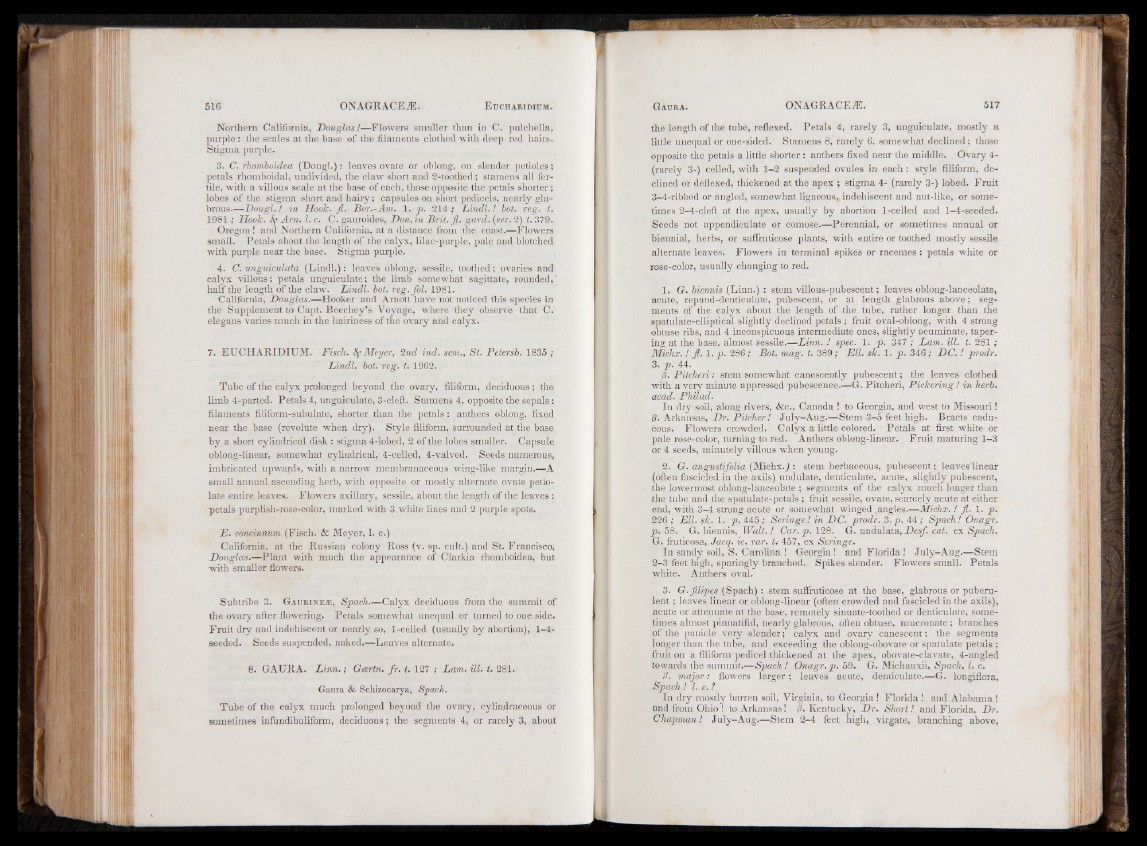
Northern California, Douglas!—Flowers smaller than in C. pulchella,
purple: the scales at the base of the filaments clothed with deep red hairs.
Stigma purple,
3. C. rhomboidea (Dougl.): leaves ovate or oblong, on slender petioles;
petals rhomboidal, undivided, the claw short and 2-toothed; stamens all fertile,
with a villous scale at the base of each, those opposite the petals shorter;
lobes of the stigma short and hairy; capsules on short pedicels, nearly glabrous.—
Dougl.! in Hook. jl. Bor.-Am. 1. p. 214 ; Lindl.! bot. reg. t.
1981; Hook. Sf Am. l.c. C. gauroides, Don, in Brit. jl. gard. (ser. 2) t. 379.
Oregon ! and Northern California, at a distance from the coast.—Flowers
small. Petals about the length of the calyx, lilac-purple, pale and blotched
with purple near the base. Stigma purple.
4. C. unguiculata (Lindl.): leaves oblong, sessile, toothed; ovaries and
calyx villous; petals unguiculate; the limb somewhat sagittate, rounded,'
half the length of the claw. Lindl. bot. reg.fol. 1981.
California, Douglas.—Hooker and Arnott have not noticed this species in
the Supplement to Capt. Beechey’s Voyage, where they observe that C.
elevens varies much in the hairiness of the ovary and calyx.
7. EUCHARIDIUM. Fisch. Sp Meyer, 2nd ind. sem., St. Petersb. 1835 ;
Lindl. bot. reg. t. 1962.
Tube of the calyx prolonged beyond the ovary, filiform, deciduous ; the
limb 4-parted. Petals 4, unguiculate, 3-cleft. Stamens 4, opposite the sepals:
filaments filiform-subulate, shorter than the petals : anthers oblong, fixed
near the base (revolute when dry). Style filiform, surrounded at the base
by a short cylindrical disk : stigma 4-lobed, 2 of the lobes smaller. Capsule
oblong-linear, somewhat cylindrical, 4-celled, 4-valved. Seeds numerous,
imbricated upwards, with a narrow membranaceous wing-like margin.—A
small annual ascending herb, with opposite or mostly-alternate ovate petio-
late entire leaves. Flowers axillary, sessile, about the length of the leaves :
petals purplish-rose-color, marked with 3 white lines and 2 purple spots.
E. condnnum (Fisch. & Meyer, 1. c.)
California, at the Russian colony Ross (v. sp. cult.) and St. Francisco,
Douglas.—Plant with much the appearance of Clarkia rhomboidea, but
with smaller flowers.
Subtribe 3. Gaurineæ, Spach.—Calyx deciduous from the summit of
the ovary after flowering. Petals somewhat unequal or turned to one side.
Fruit dry and indéhiscent or nearly so, 1-celled (usually by abortion), 1-4-
seeded. Seeds suspended, naked.—Leaves alternate.
8. GAURA. Linn. ; Geertn. fr. t. 127 ; Lam. ill. t. 281.
Gaura & Schizocarya, Spach.
Tube of the calyx much prolonged beyond the ovary, cylindraceous or
sometimes infundibuliform, deciduous ; the segments 4, or rarely 3, about
the length of the tube, reflexed. Petals 4, rarely 3, unguiculate, mostly a
little unequal or one-sided. Stamens 8, rarely 6, somewhat declined; those
opposite the petals a little shorter : anthers fixed near the middle. Ovary 4-
(rarely 3-) celled, with 1-2 suspended ovules in each : style filiform, declined
or deflexed, thickened at the apex ; stigma 4- (rarely 3-) lobed. Fruit
3-4-ribbed or angled, somewhat ligneous* indehiscent and nut-like, or sometimes
2-4-cleft at the apex, usually by abortion 1-celled and 1-4-seeded.
Seeds not appendiculate or comose.—Perennial, or sometimes annual or
biennial, herbs, or suffruticose plants, with entire or toothed mostly sessile
alternate leaves. Flowers in terminal spikes or racemes: petals white or
rose-color, usually changing to red.
1. G. biennis (Linn.) : stem villous-pubescent; leaves oblong-lanceolate,
acute, repand-denticulate, pubescent, or at length glabrous above; segments
of the calyx about the length of the tube, rather longer than the
spatulate-elliptical slightly declined petals ; fruit oval-oblong, with 4 strong
obtuse ribs, and 4 inconspicuous intermediate ones, slightly acuminate, tapering
at the base, almost sessile.—Linn. ! spec. 1. p. 347 ; Lam. ill. t. 281 ;
Michx. ! jl. 1. p. 286; Bot. mag. t. 389; Ell. sk. 1. p. 346; DC. ! prodr.
3. p. 44.
,8. Pitcheri: stem somewhat canescently pubescent; the leaves clothed
with a very minute appressed pubescence.—G. Pitcheri, Pickering ! in herb,
acad. Philad.
In dry soil, along rivers, &c., Canada ! to Georgia, and west to Missouri!
18. Arkansas, Dr. Pitcher! July-Aug.—Stem 3-5 feet high. Bracts caducous.
Flowers crowded. Calyx a little colored. Petals at first white or
pale rose-color, turning to red. Anthers oblong-linear. Fruit maturing 1—3
or 4 seeds, minutely villous when young.
2. G. angustifolia (Michx.) : stem herbaceous, pubescent; leaves'linear
(often fascicled in the axils) undulate, denticulate, acute, slightly pubescent,
the lowermost oblong-lanceolate; segments of the calyx much longer than
the tube and the spatulate-petals ; fruit sessile, ovate, scarcely acute at either
end, with 3-4 strong acute or somewhat winged _angles.-—Michx. ! jl. 1 . p.
226 ; Ell. sk. 1. p. 445; Seringe! in DC. prodr. 3. p. 44 ; Spach! Ouagr.
p. 58. G . biennis, Walt. ! Car. p. 128. G. undulata, Desf. cat. ex Spach.
G. fruticosa, Jacq. ic. rar. t. 457, ex Seringe.
In sandy soil, S. Carolina ! Georgia! and Florida! July-Aug.—Stem
2-3 feet high, sparingly branched. Spikes slender. Flowers small. Petals
white. Anthers oval.
3. G. fdipes (Spach): stem suffruticose at the base, glabrous or puberu-
lent ; leaves linear or oblong-linear (often crowded and fascicled in the axils),
acute or attenuate at the base, remotely sinuate-toothed or denticulate, sometimes
almost pinnatifid, nearly glabrous, often obtuse, mucronate ; branches
of the panicle very slender; calyx and ovary canescent; the segments
longer than the tube, and exceeding the oblong-obovate or spatulate petals ;
fruit on a filiform pedicel thickened at the apex, obovate-clavate, 4-angled
towards the summit.—Spach ! Onagr. p. 59. G. Michauxii, Spach, l. c.
0. major: flowers larger ; leaves acute, denticulate.—G. longiflora,
Spach ! 1. c. 1
In dry mostly barren soil, Virginia, to Georgia ! Florida ! and Alabama !
and from Ohio ! to Arkansas! (i. Kentucky, Dr. Short! and Florida, Dr.
Chapman! July-Aug— Stem 2-4 feet high, virgate, branching above,